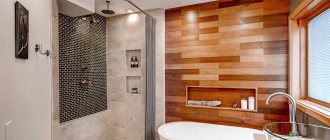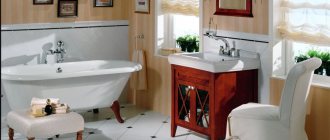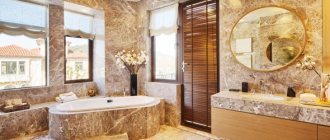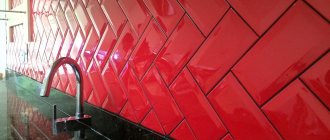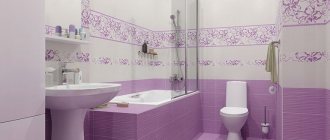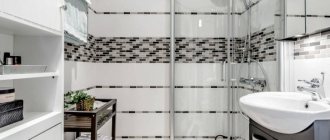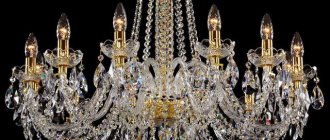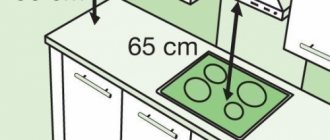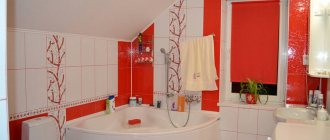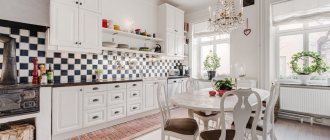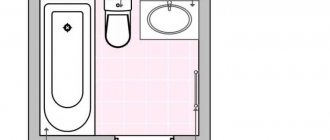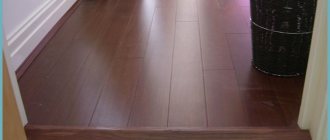Types of tile products and their features
When choosing decoration, first familiarize yourself with the types of wall panels. The type of construction depends on the material used.
Wall decoration
The size of the tile panel in the bathroom is influenced by the area of the room. Having decided on the design, you can correct the flaws in the space and take care of the appearance.
If the room is large, then choose panels of considerable size accordingly. It could be a marine theme, which is most suitable for the bathroom. To visually enlarge the space, use an image without a plot, for example, abstractions and lines.
Panel sizes and shapes
The panel can consist of 2, 3, 4, 6, 9 or more parts, or the design can be applied to one large tile. Most often, the ceramic tiles from which the image is made have the shape of a square or rectangle, but there are also other shapes - friesize (i.e., free size), where the image is assembled from elements in any order, like a puzzle.
Rectangular tiles arranged vertically will help visually increase the height of the kitchen apron, while those laid horizontally will stretch it in width.
Variations of wall panels
More recently, photo panels have appeared - this product is made to order; the customer provides any photo as a drawing, which is transferred to the tile.
Using a mirror design will help increase the size of a small room; sometimes a pattern is applied to the surface. For small rooms, a small product made from one type of tile is suitable.
A panel depicting a 3D picture is made of durable and resistant material.
Mosaic is a rather labor-intensive type, but if you choose just such a panel, then it’s worth it, almost all buyers are satisfied with the effect.
Tiles for kitchen panels
Tile is the main material for creating panels. Therefore, it must have the basic functional qualities of a kitchen apron:
- Low porosity - so that dirt and grease do not penetrate into the structure of the tile, it gets dirty less, and is easy to clean.
- Durability is the key to long-term color retention and abrasion resistance. For the kitchen apron area, class “PEI-III” is recommended.
- Resistance to detergents – the surface must resist the action of chemicals. The most stable class is “AA”.
Important elements in the design of kitchen panels are the shape, color of the tiles, and method of installation. Like any material, tiles have their advantages and disadvantages. We summarize all the characteristics of ceramics in a table.
| Advantages | Flaws |
|
|
Form
Form matters. The more common and easier to install tiles are square ones. It is easier for her to calculate the size of the apron, the amount of material, and it is easier to position it relative to other interior details. The most common sizes are 2.5x2.5 cm, 5x5 cm. Among small mosaic shapes - 2x2 cm and even 1x1 cm.
In addition to square shapes, there are rectangular ones (for example, 2.5 × 5 cm), round ones for mosaics, etc. The manufacturer also offers thin porcelain tiles, which are mounted in large sheets up to 150 × 320 cm in size.
Surface
A matte or glossy surface of the material is considered more hygienic. Tiles with three-dimensional elements and relief become dirty easily and are difficult to wash. Therefore, it is not recommended to use it in the hob area.
On glazed and glass tile surfaces, drops of grease and dirt are more noticeable. This will require more careful care. Matte ceramics are a democratic way out of this situation.
Kinds
A wide range of tiles allows customers to find what interests them. Ceramics can be:
- Texture – imitate wood, stone.
- Metallized - surface like gold, silver, bronze...
- Textile - the illusion is created that the tile is woven from threads of flax, silk, wool. Looks like a piece of fabric.
- Volumetric - the tile has 3D details of different shapes and sizes.
Number of tiles for the panel
The required amount of material is calculated from the size of the panel itself, the size and shape of the tile, and the installation method. There are 3 main installation options: vertical, horizontal and diagonal. The material consumption in the latter method will be greater.
When planning panels for the kitchen, experiment with shape, color, texture. Before installation, visually compare the drawing with the furniture and the interior as a whole. Take into account all the criteria for tiles for panels, then your interior will be stylish and cozy.
Mosaic
It is considered the most common wall decor. The pattern is laid out from different shades of tiles no more than 3 cm wide. Each element of the pattern is held on the wall using a metal mesh.
It is worth noting the advantages of such a panel:
- tiles are made in a wide variety of textures and are covered with a layer of glaze, making it resistant to different humidity levels;
- mosaic appearance, like crystal, which contributes to spectacular external beauty;
- thanks to the design, you can make internal lighting;
- During manufacturing, the material is polished to ensure many years of use.
The mosaic can be laid out in any order or according to instructions to get a geometric pattern. This option is suitable for a classic bathroom.
For Provence, floral patterns in beige shades or shells are suitable. You can see more combinations in our article. We laid out a whole series of tile panels in the photo. Review and study.
Types of tiles
The abundance of modern decorative materials makes it possible to easily implement various ideas, create a panel of tiles for the bathroom, and make it cozy.
Ceramic
This finishing material is often used when tiling a bathroom. Ceramic tiles for the bathroom have a lot of positive features for which customers appreciate them.
Pros:
- ease of use and cleaning;
- moisture resistance;
- ease of installation;
- mildew resistance;
- increased strength;
- low, affordable cost.
Therefore, ceramic tiles are often used as a finishing material for decorating a bathroom using a wall composition.
Glass tiles
The types of its surface are different - matte, corrugated, smooth, with slots and patterns. Squares of material 10*10 are used to create finishing. Using such a glass picture, you can decorate an empty wall or part of it, equipping it with special lighting for greater effect.
Phototile
This material can be used to decorate a bathroom and create rich, bright colors. Phototiles are applied to a specific section of the wall or to the entire surface, choosing a pattern to your liking.
There is a great demand for images for bathroom decoration:
- wild nature, tropics or exotic beaches;
- water theme - with fish, jellyfish, shells;
- ship or boat with sail;
- orchid taken close up.
Family photographs are often used, framed as a whole picture or broken into parts. It is allowed to use several small photographs.
When creating a photo panel, each fragment of the picture is fired in an oven at temperatures up to 1000°C, so professionals claim that the image will remain intact and will not lose its appearance for 50 years.
The cost of such material is no more than high-quality tiles, so it is often ordered for finishing a bathroom.
Mosaic
A prefabricated image is a popular option for decorating bathroom walls. When decorating an interior, the overall plot of the picture consists of several parts applied to a separate detail. When assembling all the elements of the tile composition, they are joined so that the joints are not visible. Mosaic images can be up to three meters in size and have any shape and shade.
When creating work, squares (30 mm) are often used, although real masterpieces are obtained from shapeless pieces of colored minerals. Therefore, the composition is an expensive pleasure, which not everyone can equip.
Expert opinion
Olga Kovalenko
Since 2010 I have been engaged in interior design and architectural design.
You should not decorate the walls with a mosaic image in a small bathroom, since the painting will look best only in a large room.
With 3D drawing
Modern technologies are used to produce compositions with a 3D effect, so the design applied to the tiles looks natural. Mandatory firing of the photo print at a temperature of about 1000°C protects the material from the destructive effects of humidity and prevents damage to the image; the paint penetrates into the tile and is fixed there. After firing, the surface of the part is treated with a special glaze.
Advantages of 3D image format:
- long operation;
- ease of care;
- mildew resistance;
- no difficulties during installation;
- impact resistance.
The 3D image changes the feeling of space, so this composition is considered a unique finishing material used to create an original interior. It is usually made for a specific room. Before starting finishing, you need to take into account the size, configuration of the room, choose lighting so that the picture looks full and decorates the bathroom.
Panels and ceramic material
Thanks to the huge selection of textures and shades, ceramic panels are quite popular among consumers today.
Tile features:
- simple way of laying;
- affordable price;
- ideal operating characteristics;
- resistant to chemicals and various types of damage;
- withstands different temperature changes.
Porcelain tile panel
Porcelain tiles allow the product to serve for many years without deforming or changing its appearance. The properties of the material are superior in quality to tiles.
- Karaca Home bed linen – affordable luxury
Curtain patterns - instructions on how to sew curtains with your own hands. Step-by-step guide + master class (150 photos of new designs)
Tulle for the hall - 150 photos of the best new products and exclusive design. TOP unusual design solutions of 2020
Positive qualities of porcelain stoneware:
- the material is suitable for rooms with high humidity;
- does not wear out and has excellent strength indicators;
- images of varying complexity are applied;
- ease of care.
Please note that porcelain stoneware is slippery; it is better not to use it as a floor covering.
Features of installing tile panels in the kitchen
Before directly laying it on the wall, lay the panel on the floor so that it is convenient to take the necessary measurements. If the size of the composition does not match the space allocated to it, try to trim the edges in such a way as to achieve symmetry.
When laying, pay attention to the back of the tile, since the components of the overall picture are numbered there. There is an option to lay tiles with seams or use a rectified type of tile - without seams. In order not to spoil the single composition with seams, they are made within 1 mm. The grout can be used transparent, matched to the main color or made contrasting.
Attention ! When the rectangles are arranged vertically, the height of the apron visually increases; when placed horizontally, it expands in width.
The tiles are laid on tile adhesive, which has good viscosity and takes a long time to set, so the first row often begins to shift. To prevent this from happening, place a drywall profile or a wooden batten under the tile, temporarily screwing the structure to the wall.
Here are some installation recommendations:
- the panel cannot be cut;
- tiles with relief should not be laid in a corner, as adjacent elements will create gaps;
- it is important that the pattern is located in the center of the main wall, with even trimming on the sides if necessary;
- It’s better not to use a large number of bright paintings so as not to overload the interior.
Also think about the possibility of using friezes and borders in the design of panels. They create a frame around the panel, giving it an even greater resemblance to a painting. The border also helps to harmonize the panel and the base tile in color or texture.
Tile photo panel
This type is popular among designers. The product allows you to create bright patterns, designs and ornaments. In addition, you can lay out tile panels in the kitchen. Conditions allow you to decorate a small part or the entire wall.
Photo tiles will help you create a whole picture or several fragments of it on the wall. Typically this type is used for finishing mirrors, doors or illuminated niches.
Stained glass panels
Stained glass is a design made with glass mosaic. It comes in the form of pictorial images, ornaments and patterns, abstractions, silhouettes and contours. Most often, stained glass windows in the kitchen are used in the manufacture of furniture facades.
The advantages of using glass patterns include their spectacular appearance and the ability to match stained glass to any set due to the variety of patterns and shapes.
Keep in mind that this option is difficult to maintain. Grease stains constantly appear on it during cooking and splashes of water after washing dishes. The proximity of the apron to the hob also has a negative impact. Exposure to high temperatures and aggressive detergents can damage the surface, so it is better to make stained glass windows for the kitchen classic or sandblasted. It is better to refuse film and painted ones.
Glass tiles
A glass panel on the wall is a combination of shades based on glass. Used as decorative elements for empty parts of the wall. You can optionally integrate lighting into the design.
Features of glass tiles:
Blackout curtains: TOP-150 photos of new designs. Non-standard solutions for combining light-proof curtains in the interiorCurtains for the kitchen - 120 real photos of new designs. Options for the ideal combination of modern curtains in the kitchen interior
- How to hang curtains - step-by-step instructions with photo examples and recommendations. Exclusive curtain design solutions from experienced craftswomen
- it allows you to make accent inserts in the interior;
- suitable for modern design trends.
Caring for kitchen tile panels
To ensure that caring for ceramic panels is not burdensome, choose a matte finish for the tiles. It hides splashes better than glazed and glass tile surfaces. In the cooking area, the original design element should be protected as much as possible from the negative effects of the surrounding kitchen environment.
Any detergents that do not contain abrasives are suitable for caring for decorative ceramic paintings.
Glass panels cannot be heated above 80 degrees and cannot create sudden temperature changes, otherwise the glass will deform.
Panel with 3D pattern
More recently, products have appeared on which images appear as if they were alive. Photo prints must be fired to protect the panels from moisture. The surface is covered with glaze and the paints have an attractive appearance, without succumbing to various types of damage.
The 3D effect panel has a long service life and is also easy to install. By choosing such a tile, you can change the feeling when you enter the room.
Kitchen panel size
When planning your kitchen interior, choose the right size for the apron on which the panel will be placed. The apron should coincide well with the boundaries of the set; cover the joints with plinths. The installation time, cost of materials and work depend on the number of tiles, design, and size.
In addition to the standard sizes of panels available for sale, manufacturers offer free-size models - tiles with an endless pattern. Such paintings can be laid out to any height and width of the room. An example of walls that visually increase the height is tile with bamboo, which “grows” upward without restrictions.
Tips for choosing the right panel
When choosing a panel for the wall, you need to take into account the color scheme in the room and the size of the space.
- If the room is small, then a monochrome combination with insignificant accent inserts is suitable here.
- A panel made of ceramic material will increase the dimensions of the bathroom.
- Choose bright and dark shades if the room is large to avoid a gloomy effect.
- If the bathroom has a retro style, abstractions will do.
- If you want relaxation, then opt for sea images. The option suits the Mediterranean direction.
- For a classic or baroque look, lay out pastel-colored tiles with butterflies or a landscape on the wall.
- Oriental style involves bright colors.
- In a room with a country interior, a light and matte finish would be suitable.
- In a small bathroom it is recommended to use a natural theme
The panel is selected depending on your preferences, interior style and room dimensions. If there are many people living in the apartment, then you need to consult with them. A budget option is a panel made to order.
Please note that the tiles will last for many years, so choose a good design so that it does not get boring and has a good effect on the overall condition.
- Curtain tiebacks - 150 photos of new exclusive designs
Do-it-yourself tulle - step-by-step instructions on how to sew beautiful tulle. Photos of ready-made ideas and modern design
Curtains for gray wallpaper - options for the ideal combination of curtains in a gray interior (TOP-150 photos of new designs)
Panel for the kitchen
Decorating kitchen walls with ceramics is a creative process that is never boring. The result will be not only a unique interior created by your hands, but also a stylish room.
Mosaic
The most famous and long-used type. It easily fits into any style, but has a significant drawback - a large number of seams that will accumulate dirt. For this it is recommended to use glass grout.
Mosaic technique:
- Laying out paintings or abstract patterns from miniature tiles about 2 cm in size. The result obtained is best viewed from afar, in the whole composition.
- The drawing is created from pieces of broken ceramics, turning into a unique work of art. To create such a panel, you can hire specialists or save money and create a picture yourself. The technique is not complicated, but such an activity will require perseverance and painstakingness.
Laying out ceramic mosaics can become your hobby: decorate other interior items (window sills, vases, tabletops, etc.) in the same style, zone the space or place emphasis on certain places.
A subtype of this technique includes mosaics made from ceramic pieces of complex shapes. To do this you will need a tile cutting tool.
Hand painted
Large tiles are used for this panel. The surface is hand-painted with ceramic paints, then fired and glazed. Externally, the tile differs from the store-bought one only in the image and price. This pattern is resistant to washing off and fading for a long time. An important feature of this panel is that it looks like a real painting.
Photoceramics
A ceramic apron decorated using this technology has the most reliable pattern, resistant to physical damage and time. This method of decoration is quite complex, time-consuming, and is done manually.
First, the image is printed on decal paper using ink consisting of organic and inorganic components. The design is transferred to the tile, then it is baked at temperatures above 800 degrees for about 10 hours. The organic component burns, and the inorganic component is firmly connected to the surface of the material into a single whole. The result obtained is superior to hand painting. And it is true.
